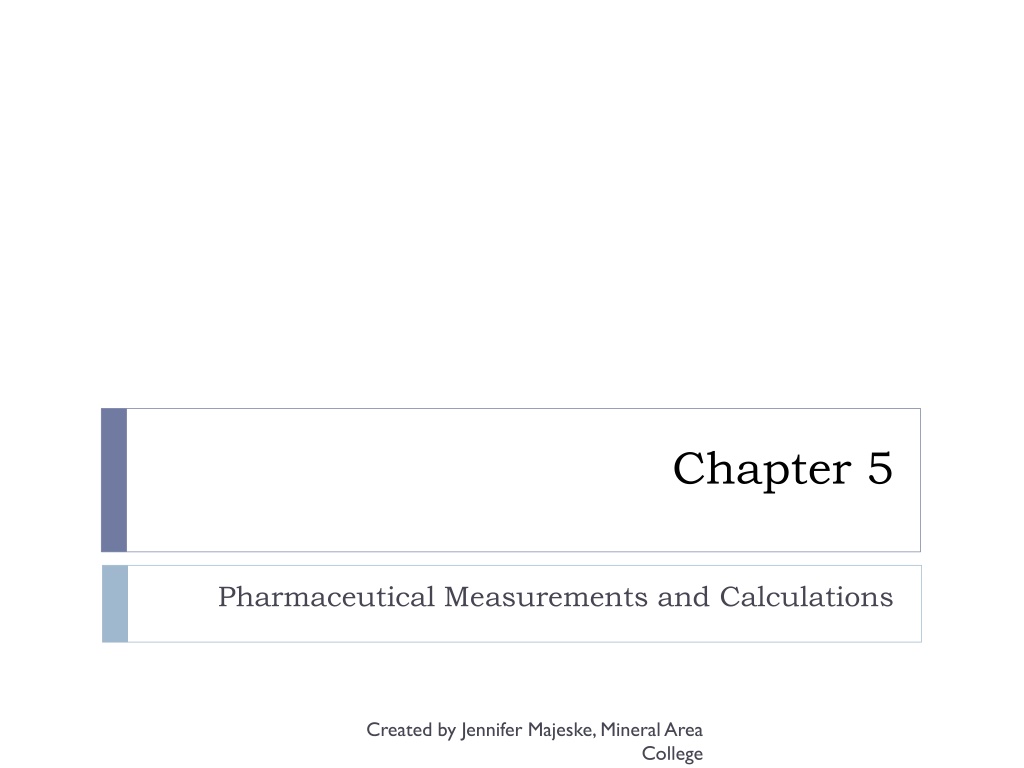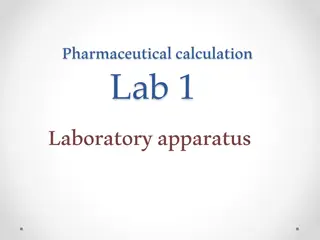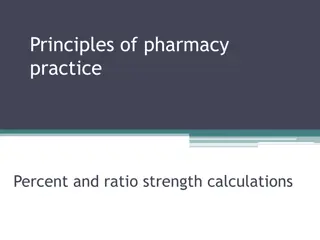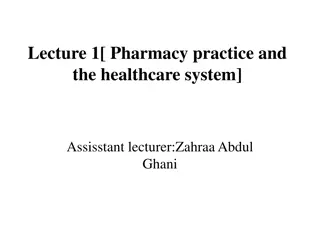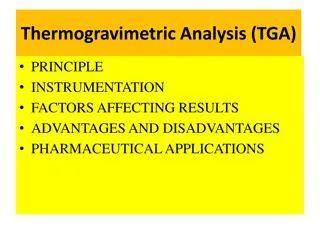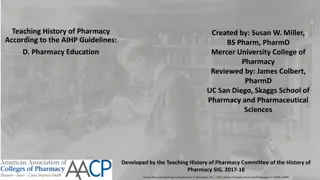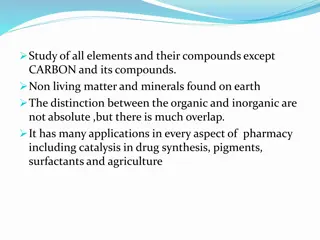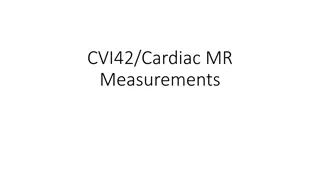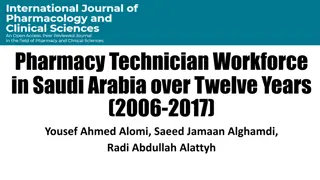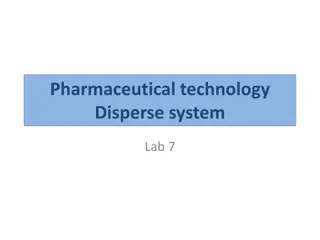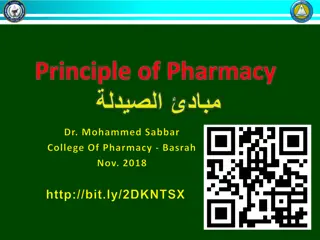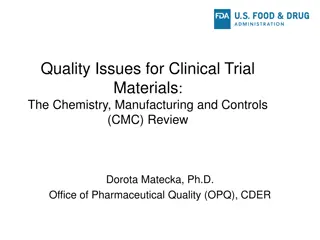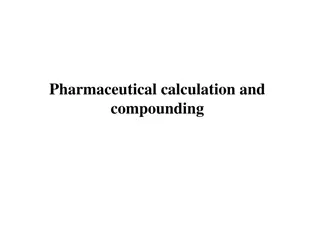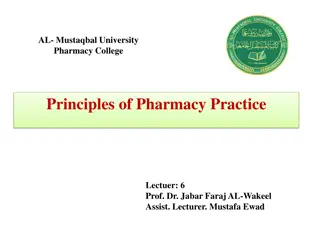Pharmaceutical Measurements and Calculations in Pharmacy
Understanding pharmaceutical measurements and calculations is crucial for pharmacy technicians to prevent calculation mistakes with serious consequences. This article covers the systems of measurement used in pharmacy, including the Metric System, basic math fundamentals necessary for pharmacy work, and the importance of accurate measurements in daily pharmacy activities. Topics such as unit conversion, proportions, dosage calculations, and preparation of solutions are also discussed. Created by Jennifer Majeske from Mineral Area College.
Download Presentation

Please find below an Image/Link to download the presentation.
The content on the website is provided AS IS for your information and personal use only. It may not be sold, licensed, or shared on other websites without obtaining consent from the author. Download presentation by click this link. If you encounter any issues during the download, it is possible that the publisher has removed the file from their server.
E N D
Presentation Transcript
Chapter 5 Pharmaceutical Measurements and Calculations Created by Jennifer Majeske, Mineral Area College
Learning Objectives Describe four systems of measurement commonly used in pharmacy and convert units from one system to another. Explain the meanings of the prefixes most commonly used in metric measurement. Convert from one metric unit to another. Convert Roman numerals to Arabic numerals. Convert temp to and from the Fahrenheit and Celsius scales. Round decimals up and down appropriately. Created by Jennifer Majeske, Mineral Area College
Learning Objectives Perform basic operations with proportions, including identifying equivalent ratios and finding an unknown quantity in a proportion. Convert percentages to and from fractions, ratios, and decimals. Perform fundamental dosage calculations and conversions. Solve problems involving powder solutions and dilutions. Use the alligation method to prepare solutions. Calculate the specific gravity of a liquid. Created by Jennifer Majeske, Mineral Area College
Introduction Daily activities in the pharmacy, by pharmacists and technicians, requires making exact measurements. A calculation mistake can have severe consequences, like drug toxicity or patient death. It is fundamental for pharmacy technicians to understand the basic measurement systems and mathematical calculations and formulas used in the healthcare field. Why is a knowledge of basic math fundamentals necessary? Created by Jennifer Majeske, Mineral Area College
Systems of Pharmaceutical Measurement Systems of measurements are widely accepted standards to determine quantities temperature, distance, volume, and weight are most important to the pharmacy profession. Quantities of temp and weight are the simplest and most familiar measurements. Distance is a measurement of extension in space in one dimension. Volume, is a measurement of extension in space in three dimensions. Created by Jennifer Majeske, Mineral Area College
The Metric System Metric system: the legal standard of measure for pharmaceutical measurements and calculations in the U.S. Based on decimal notation, units are described as multiples of ten (0.001, 0.01, 0.1, 1, 10, 100, 1000). Contains clear correlations among units of measurement of length, volume, and weight. Metric system is used worldwide, a universal language. Created by Jennifer Majeske, Mineral Area College
The Metric System The modern metric system makes use of the standardized units of the Syst me International (SI). To convert from one metric unit to another, simply move the decimal point. Moving the decimal to the left converts to larger units; moving the decimal to the right converts to smaller units. To prevent misreading of numbers less than one (1), a zero (0) is placed before the decimal; this is known as the leading zero. Diligence must be exercised when recording, interpreting, and measuring medication dosages containing decimals. Created by Jennifer Majeske, Mineral Area College
The Metric System Three basic units: 1) Meter (m) 2) Liter (L) 3) Gram (g) Prefixes can be added to the basic metric units to specify a particular measure. Each metric unit has its own abbreviation, both for single and plural measurements (1 mL, 3 mL; 1 g, 3 g). Created by Jennifer Majeske, Mineral Area College
Meter, Liter, and Gram Meter used for measuring distance, area, and volume and has limited application in pharmacy practice. Liter used for measuring the volume of liquid medications as well as liquids for oral and parenteral solutions. 1 L = 1000 cc (cubic centimeters) 1 cc = 1 mL (milliliter) Gram used for measuring 1) the amount of medication in a solid dosage form, 2) the amount of solid medication in a solution, and 3) express the weight of an object or person. Most pharmacy calculations involve conversions to and from grams, milligrams, and kilograms and to and from milliliters and liters. Created by Jennifer Majeske, Mineral Area College
Other Systems of Pharmaceutical Measurement A foot was originally equal in length to an average person s foot., a cubit was equal to the length of a forearm from the elbow to the middle finger. Common measurements were inconsistent and imprecise. Need for standardized measurements resulted in the establishment of three different systems of pharmaceutical measurement over the centuries: Apothecary system Avoirdupois system Household system Created by Jennifer Majeske, Mineral Area College
Apothecary System Apothecary system one of the oldest systems of measurement, based on the weight system developed by the Romans. Dram: approximately equal to 4mL Scruple: roughly equivalent to 1.3 g Grain (gr) a dry weight measure that is the most commonly encountered nonmetric unit. Other apothecary units of measure: Pint, quart, gallon, ounce, and pound Apothecary system was widely used until the beginning of the 20th century Created by Jennifer Majeske, Mineral Area College
Avoirdupois System Avoirdupois system originated in France and is considered the everyday system of measurement in the United States. Common units of measure: Feet Miles Grains shared with the apothecary system Pounds shared with the apothecary system Ounces shared with the apothecary system Created by Jennifer Majeske, Mineral Area College
Household System Household system based on the apothecary system and was established to help patients take their medications at home. Common units of measure: Ounce Pound Drop Teaspoon Tablespoon Cup Hogshead obsolete in pharmacy (1 hogshead = 238.480942 liters) Jigger obsolete in pharmacy (1 shot = 44.3602943 mL) Created by Jennifer Majeske, Mineral Area College
Conversion Equivalents Among Different Measurement Systems One challenge, prior to the 19th century, was lack of standard equivalences among the three measurement systems. Depending on the system of use, practitioners were dispensing widely different doses. Discrepancies often resulted in medication errors; a standardized system was needed to ensure accuracy in medication doses for patients which led to the adoption of the metric system. Many pharmacy computer programs only accept amounts entered in metric units. Why should pharmacy technicians be familiar with all measurement systems? Created by Jennifer Majeske, Mineral Area College
Common Practice Issues with Conversions Conversions of certain units of measure to their metric equivalents results in decimals; to simplify and standardize these conversions, rounding up or down was universally adopted in pharmacy practice. Use the rounded 30mL value for a fluid ounce. Many physicians write prescription orders in ounces of medication for liquid dosage forms; the metric system of measurement is much more accurate. Most pharmacists consider 1 gr to equal 65 mg, but some manufacturers use 1 gr to equal 60 mg. Created by Jennifer Majeske, Mineral Area College
Numeric Systems Arabic uses numbers, fractions and decimals. Roman - numerals are expressed in either lowercase or capital letters. Most frequently used Roman numerals in pharmacy are I, V, and X, which represent 1, 5 and 10. Lowercase roman numerals i, ii, and iii are occasionally used. Example: aspirin gr vi means six grains of aspirin Roman numerals are equal or smaller when reading left to right; the total value equals the sum of their individual values. Created by Jennifer Majeske, Mineral Area College
Time In the hospital setting, medication orders are commonly stamped with military or 24-hour time. Administration schedules for unit dose and IV admixtures also use this method. Military time based on a 24-hour clock, with midnight considered time 0000. 0000 Midnight 0600 6 AM 1200 Noon 1800 6 PM The first two digits are the time in hours, the second two digits are the time in minutes. No AM or PM are used, reducing confusion fewer medication errors Example 1 Created by Jennifer Majeske, Mineral Area College
Temperature Fahrenheit temperature scale: 32 F when water freezes 212 F when water boils Celsius temperature scale: 0 C as the freezing point 100 C as the boiling point Celsius is the scale used in healthcare settings, including pharmacy. Most refrigerators in the pharmacy need to maintain a 2 C to 8 C temperature. Created by Jennifer Majeske, Mineral Area College
Temperature Storing of drugs under proper temperature is an important responsibility of the pharmacy technician. Pharmacy refrigerators (for medications) should be maintained between 5 and 10 C. Every 5 C change in temperature equals a 9 F change. F = (1.8 x C) + 32 C = ( F - 32 ) 1.8 5 x F = 9 x C + 160 (alternative method) Most pharmacy temperature logs document to the tenth place for accuracy. If a decimal is not required, then the temperature should be rounded down if it is 0.1 0.4 and rounded up if 0.5 0.9. Examples 2 6 Created by Jennifer Majeske, Mineral Area College
Basic Calculations Used in Pharmacy Practice Fractions: when something is divided into parts. Numerator the number on the top or the left Denominator the number on the bottom or the right A pie divided into eight slices, each slice represents a fraction, or 1/8 of the whole pie. 1 is one slice of pie, 8 is the number of slices in the whole pie. (see Figure 5.2 pg. 170) 6/3 = 6 divided by 3, which equals 2. 7/8 = 7 divided by 8, which equals 0.875 The number obtained upon dividing the numerator by the denominator is the value of the fraction. Created by Jennifer Majeske, Mineral Area College
Decimals Most medication orders are written using decimals. Decimal any number that can be written in decimal notation using the integers 0 9 and a point (.) to divide the ones place from the tenths place. Numbers to the left of the decimal point are whole numbers; numbers to the right of the decimal point are decimal fractions (parts of the whole). Leading zero the zero (0) placed before the decimal point if a decimal is less than one. A fraction can be expressed as a decimal by dividing the numerator by the denominator. Created by Jennifer Majeske, Mineral Area College
Converting Decimals to Fractions The metric system usually used numbers in decimal form. Any decimal number can be expressed as a decimal fraction that has a power of 10 as its denominator. Created by Jennifer Majeske, Mineral Area College
Converting Decimals to Fractions To express a decimal as a fraction, remove the decimal point and use the resulting number as the numerator. To obtain the denominator, count the number of places to the right of the decimal point. 2.33 = 233 100 0.1234 = 1234 367 100000.00367 = 100,000 Once a decimal number is expressed as a fraction, the fraction should be reduced or simplified. 0.84 = 84 100 = 84 100 4 4 = 21 25 Created by Jennifer Majeske, Mineral Area College
Rounding Decimals To round to the nearest tenth, carry the division out two places, to the hundredths place. If the number is greater than 5, round up by adding one to the tenths-place number; if less than 5 round down by omitting the digit in the tenths place. In pharmacy calculations it is common to round off to the nearest tenth. Sometimes it may be necessary to round to the nearest hundredth or thousandth. Check with the pharmacist to confirm proper rounding practices. Created by Jennifer Majeske, Mineral Area College
Ratios and Proportions Ratio: a comparison of two like quantities and can be expressed in a fraction or in ratio notation. Example: two parts water to three parts alcohol. What would the ratio look like? Common use of ratios is the number of parts of one substance contained in a known number of parts of another substance. Ratios that have the same value, and 2/4 are said to be equivalent ratios. When ratios are equivalent, the product of the numerator (of the first ratio) and the denominator (of the second ratio) is equal to the product of the denominator (of the first ratio) and the numerator (of the second ratio) Created by Jennifer Majeske, Mineral Area College
Ratios and Proportions Proportions: are pairs of equivalent ratios. ? ? = ? ? a:b = c:d The first and the fourth numbers are the extremes; the second and third numbers are the means. The product of the extremes equals the product of the means. If ? then a x d = b x c ? = ? ? Table 5.11 Rules for Solving Proportions Unknown quantities are expressed using letters, x, y, and z. Examples 7 & 8 Created by Jennifer Majeske, Mineral Area College
Converting Quantities between the Metric and Common Measure Systems Many situations in the pharmacy call for converting between one system of measure and another. When possible, convert to the metric system because it is the preferred system. Know the equivalent measures. Examples 9 14 Created by Jennifer Majeske, Mineral Area College
Calculating Dosages One of the most common calculations is that of dosage(s). The available supply is usually labeled as a ratio. ?????? ?????????? (?????????) ???????? (?????????) The unknown quantity is the amount needed to achieve the desired dose of the active ingredient. ?????? ?????????? (?? ?? ????????????) ???????? (??????) ?????? ?????????? (?? ?? ????????????) ???????? (??????) When solving medication-dosing problems, use ratios to describe the amount of drug in a dosage form. Remember that the numerators and denominators of both ratios must be in the same units. Examples 15 & 16 = ?????? ?????????? (?????????) ???????? (?????????) Created by Jennifer Majeske, Mineral Area College
Converting Quantities between the Metric and Common Measure Systems Body surface area (BSA): is an expression of a patient s weight and height used to calculate patient- specific dosages. Medications can have wide dosage ranges, and patient s responses and adverse reactions can vary, even for adults. Most physicians prefer to prescribe to children only those medications that have a known pediatric-dose. Example 17 Created by Jennifer Majeske, Mineral Area College
Percents Percent comes from the Latin phrase per centum, meaning in one hundred. Percent: a given part or amount in a hundred. Percents can be expressed: An actual percent (3%) A fraction with 100 as the denominator (3/100) As a ratio (3: 100) As a decimal (0.03) Percent conversions are often calculated by the pharmacy technician. Accuracy is critical to minimizing medication errors. Created by Jennifer Majeske, Mineral Area College
Converting Ratios and Percents Designate the first number of the ratio as the numerator and the second number as the denominator. Multiply the fraction by 100 and add a percent sign after the product. 5:1 = 5 1? 100 = 5 ? 100 = 500% Created by Jennifer Majeske, Mineral Area College
Converting Ratios and Percents To convert a percent to a ratio, first change it to a fraction by dividing by 100, then reduce the fraction to lowest terms. Express this as a ratio by making the numerator the first number of the ratio, and the denominator the second number. 2 100 = 1 2% = 2 100 = 50 = 1 : 50 Created by Jennifer Majeske, Mineral Area College
Converting Percents and Decimals To convert a percent to a decimal: drop the percent sign, and divide the number by 100. Dividing a number by 100 is equivalent to moving the decimal two places to the left and inserting zeros if necessary. 0.75% = 0.75 100 = 0.0075 To convert a decimal to a percent: multiply by 100 and add a percent sign. Multiplying a number by 100 is equivalent to moving the decimal two places to the right. 0.25 = 0.25 ? 100 = 25% Created by Jennifer Majeske, Mineral Area College
Dimensional Analysis Dimensional analysis is also known as calculation by cancellation. Drug calculations have units of measure or dimensions attached to them. The dimensional analysis method is based on the principle that any number can be multiplied by one without changing its value. Example 18 Created by Jennifer Majeske, Mineral Area College
Advanced Calculations Used in Pharmacy Practice Pharmacy technicians will need to calculate the amount of ingredients required to create prescribed solutions. Parenteral products are of reconstituted by adding a diluent. The product is commercially manufactured in a powder because of the instability of the drug in solution over a long period of time. Technicians may be asked to create solutions of specific concentrations by combining measured amounts of solutions of more and less concentrations. Created by Jennifer Majeske, Mineral Area College
Preparing Solutions Using Powders When preparing solutions using powders, technicians need to be aware that the active ingredient (powder) is discussed in terms of weight, it also occupies a certain amount of space or volume. Powder volume (pv): the space occupied by a freeze- dried medication in a sterile vial; equal to the difference between the final volume (fv) and the volume of the diluting ingredient, or the diluent volume (dv). Powder volume = final volume diluent volume pv = fv dv Example 19 & 20 Created by Jennifer Majeske, Mineral Area College
Working with Dilutions Medications can be diluted for many reasons, for administration to children, infants, and older adults to meet dosage requirements, or so they can be measured more accurately and easily. First, solve for the volume of the final product by using a ratio of diluted solution to desired concentration. Second, determine the amount of diluent by subtracting the concentrate from the total volume. Example 21 Created by Jennifer Majeske, Mineral Area College
Using Alligation to Prepare Compounded Products Physicians often prescribed concentrations of medications that are not commercially available, these prescriptions must be compounded. When an ordered concentration is not commercially available, it may be necessary to combine two different products, in differing strengths, with the same active ingredients. The result is a concentration that is greater than the weaker strength, lesser than the stronger strength. Alligation: is used when the two quantities needed to prepare the desired concentrations are both relatively large. Alligation alternate method is the calculation used to determine proportions of available products needed to prepare the desired concentration. Examples 22 & 23 Created by Jennifer Majeske, Mineral Area College
Calculating Specific Gravity Specific gravity: the ratio of the weight of a substance to the weight of an equal volume of water, the standard, when both are at the same temperature. 1 mL, volume of water = 1 g, weight of water Specific gravity of water = 1 ???? ? ?? ? ????????? ???? ? ?? ?? ????? ?????? ?? ????? Viscous: thick solutions; solutions that have particles floating in them often have a specific gravity higher than 1. Solutions that contain volatile chemicals (or evaporate quickly), such as alcohol, often have a specific gravity lower than 1. Examples 24 & 25 Specific gravity = Created by Jennifer Majeske, Mineral Area College
This workforce solution was funded by a grant awarded by the U.S. Department of Labor s Employment and Training Administration. The solution was created by the grantee and does not necessarily reflect the official position of the U.S. Department of Labor. The Department of Labor makes not guarantees, warranties, or assurances of any kind, express or implied, with respect to such information, including any information on linked sites and including, but not limited to, accuracy of the information or tis completeness, timeliness, usefulness, adequacy, continued availability, or ownership. This work by Mineral Area College is licensed under the Creative Commons Attribution 4.0 International License. Created by Jennifer Majeske, Mineral Area College
